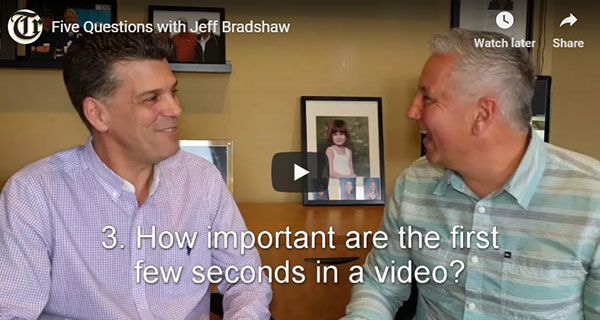 You may be a senior-level executive, an innovative entrepreneur, or a respected expert in your field – but when you’re on camera, do you know how to project leadership presence?
You may be a senior-level executive, an innovative entrepreneur, or a respected expert in your field – but when you’re on camera, do you know how to project leadership presence?
Sylvia Gorajek is a video strategist and executive producer helping Fortune 500 and Silicon Valley tech startups narrate their stories with impact. I was honoured to add my expertise in body language and leadership presence to her expertise in interviewing and producing video commercials. Here are our 10 hacks to project leadership presence on video:
1. Sylvia Gorajek: Keep laser-focused eye contact. Whether you’re looking into the camera or at an interviewer, by no means let your eyes wander. While in general it’s okay to occasionally look around, it’s a definite no-no for leaders. You have to be sharp in delivering your message. The more you keep your eyes focused, the more you’ll appear principal, knowledgeable and confident. This will also keep viewers’ attention.
2. Carol Kinsey Goman: Dress for success. It takes less than seven seconds for people to make judgments about your confidence, competence, professional status and warmth. While a face-to-face meeting gives you added opportunities to project presence – by the way you enter the meeting room, shake hands, etc. – on video, that first impression is made the moment people view you on the screen. So be sure your grooming and wardrobe send the right message.
3. Gorajek: Take five deep breaths. The silent breathing technique is a secret weapon of all on-camera hosts and presenters. Taking five deep breaths right before you hear “Action!” not only helps your body relax and your mind focus, but also straightens your posture and projects an impression of confidence and integrity.
4. Goman: Deepen your voice. The quality of your voice can be a deciding factor in how you are perceived. Speakers with higher-pitched voices are judged to be less empathic, less powerful and more nervous than speakers with lower-pitched voices. While relaxing your body (especially releasing tension from your shoulders, chest, and jaw) will deepen your voice, here is another quick and easy tip: Before you go on camera, put your lips together and say “Um hum, um hum, um hum.” Doing so drops your voice into its optimal lower pitch.
5. Gorajek: Straighten your posture. People make judgments based on someone’s posture more than on their actual role or title. While sitting comfortably or even a little slouched doesn’t do harm in real-life situations, you have to maintain good posture in front of a camera. Pay attention to how celebrities sit on a TV show and you’ll notice that they keep their backs straight throughout the whole show. This is neither comfortable nor does it feel natural, but it does wonders on camera.
6. Goman: Keep your head straight. Squaring your shoulders and keeping your head straight, with your ears in line with your shoulders, makes your look sure of yourself. When you tilt your head, you look more tentative. The only time head tilts are perceived as positive body language cues is when you’re listening to someone else speaking.
7. Gorajek: Use the right gestures. Using gestures, in general, is definitely advised as it adds energy to the video. But not all gestures work to your advantage. For example, you don’t want to have your hands anywhere near your face, since that projects a sense of uncertainty. Making wider arm movements does not look great on camera either. Keep your elbows comfortable and in line with your shoulders – you’ll appear self-assured and collected.
8. Goman: Show your palms. Keeping your movements relaxed, using open arm gestures and showing the palms of your hands — the ultimate “see, I have nothing to hide” gesture — are silent signals of credibility and candour. Individuals with open gestures are perceived more positively and are more persuasive than those with closed gestures. Hands hidden by crossing arms or held too close to the body make you look resistant or insecure.
9. Gorajek: Smile, but not too much. If your expression is neutral or too serious, you’ll come off as sad, uninterested or, worse yet, upset. If your message is positive, you should always add a smile to what you’re saying so that you project good energy and keep the audience attracted to your message. Don’t overdo it, though. The camera will give your smile a boost, and you don’t want to be viewed as naive or inauthentic.
10. Goman: Pay attention to prosody. Vocal prosody is the non-verbal aspect of speech. It’s concerned with how you say what you say. You’ll be more compelling if vary your tone, volume, intensity, inflection and rate of speech. Above all, avoid a monotone delivery that makes you sound stilted or bored. Remember, too, that there’s nothing that kills credibility faster than letting your voice rise of the end of a sentence. When making a declarative statement, be sure to use the authoritative arc in which your voice starts at one note, rises in pitch through the sentence, and drops back down at the end.
Applying these hacks will help any executive, expert or entrepreneur leverage their credibility in a video presentation. Regardless of title or industry, we should all be mindful of how to project leadership presence on camera.
Troy Media columnist Carol Kinsey Goman, PhD, is an executive coach, consultant, and international keynote speaker at corporate, government, and association events. She is also the author of The Silent Language of Leaders: How Body Language Can Help – or Hurt – How You Lead.
The views, opinions and positions expressed by columnists and contributors are the author’s alone. They do not inherently or expressly reflect the views, opinions and/or positions of our publication.


